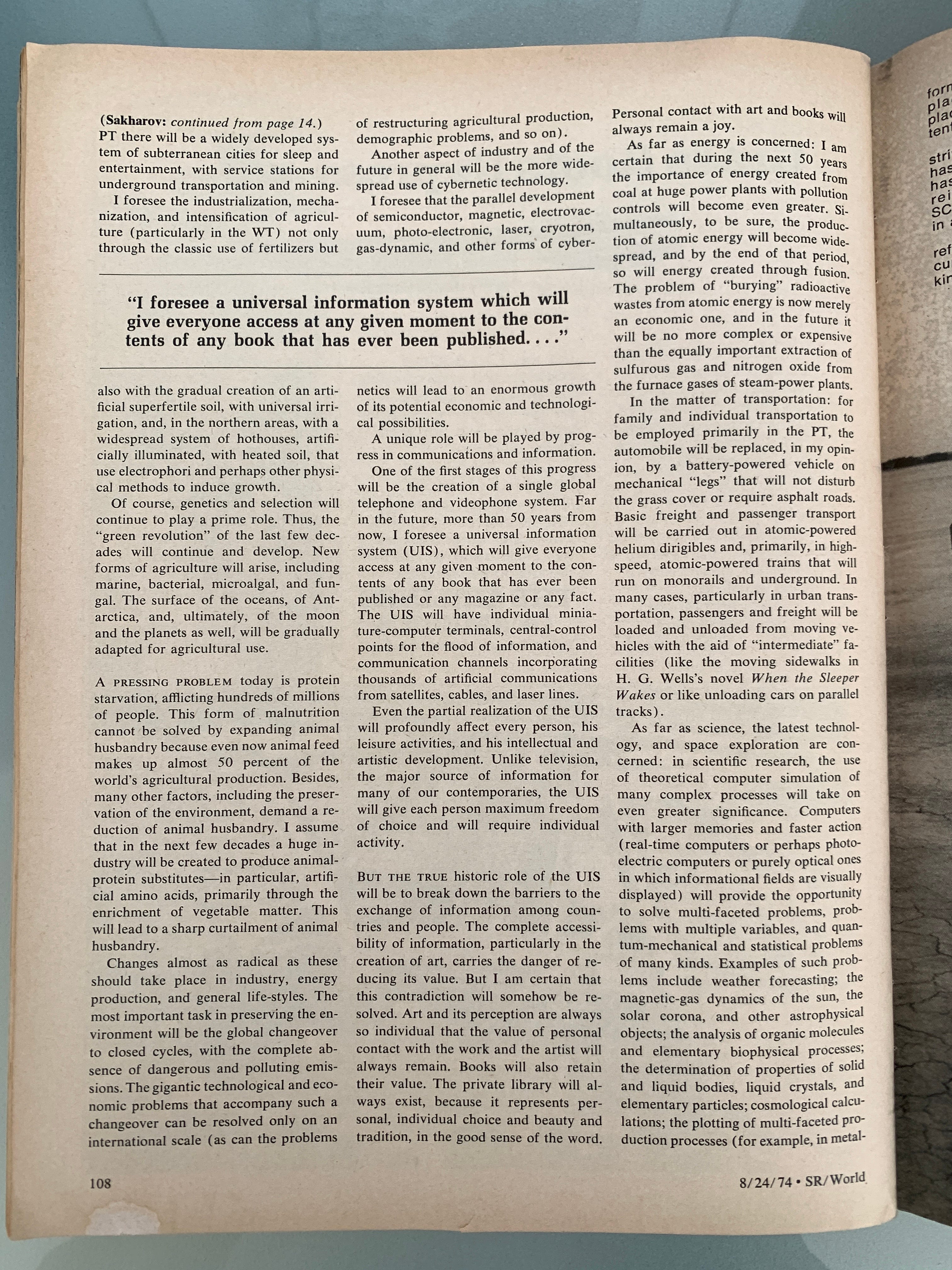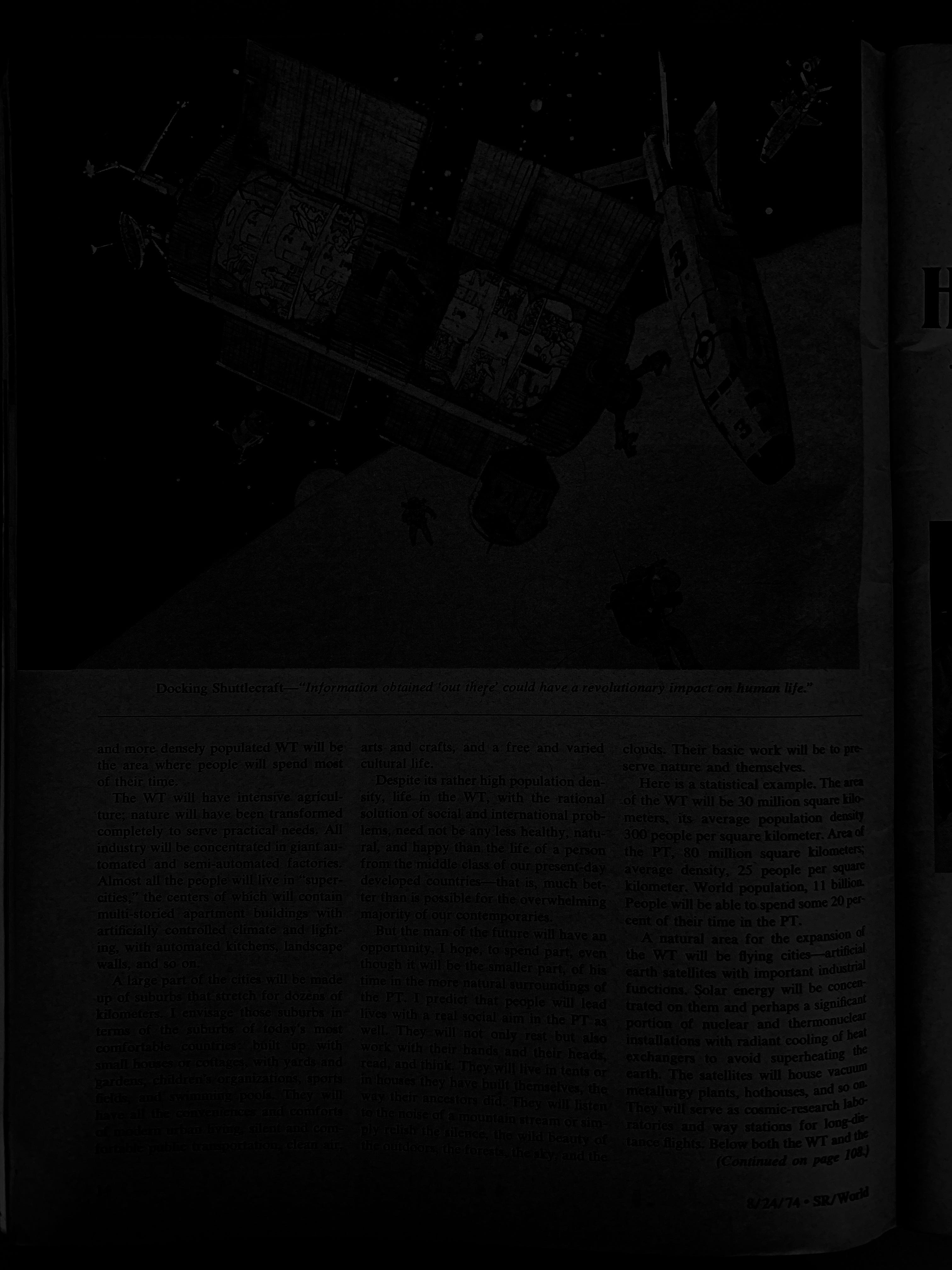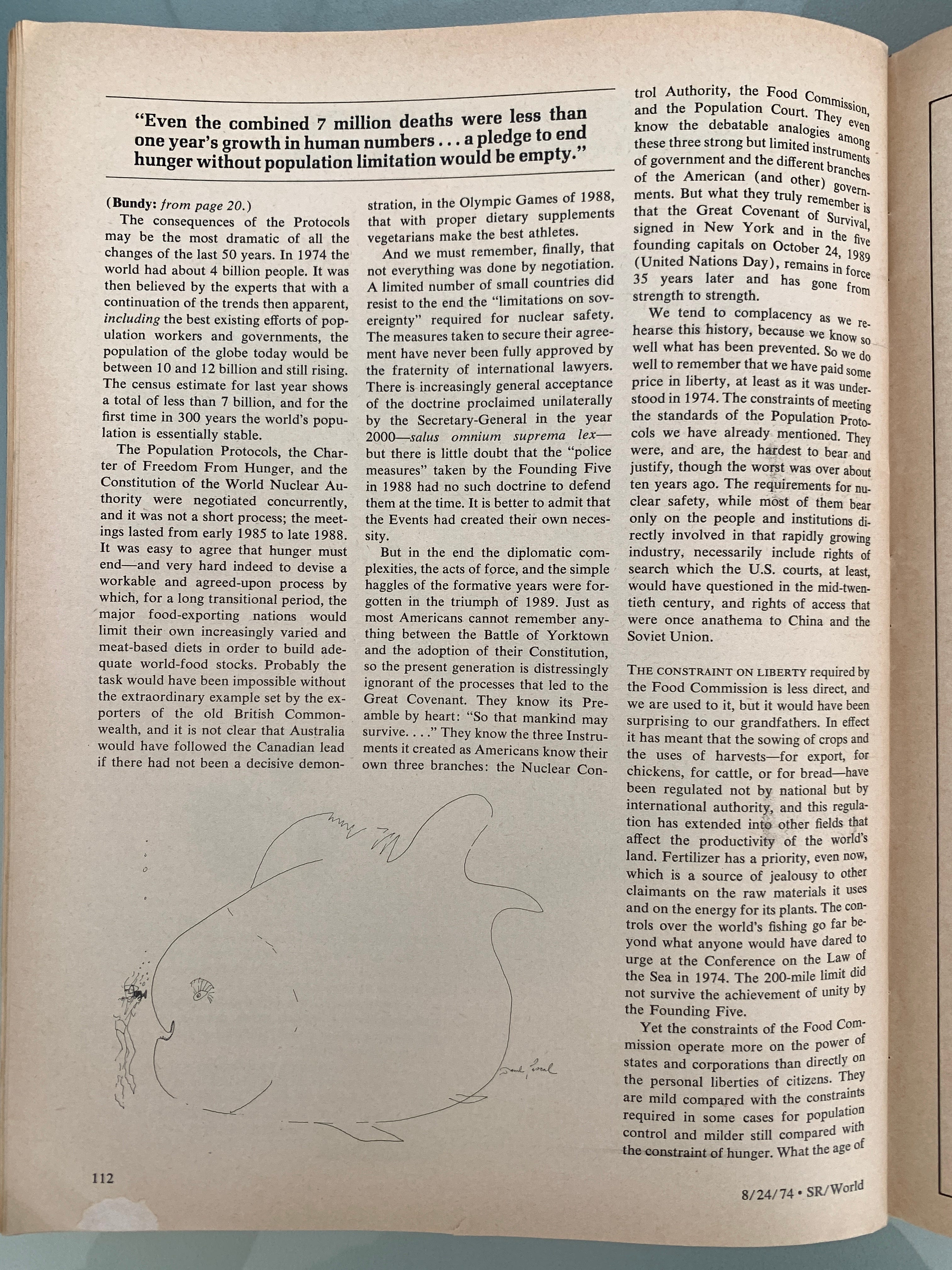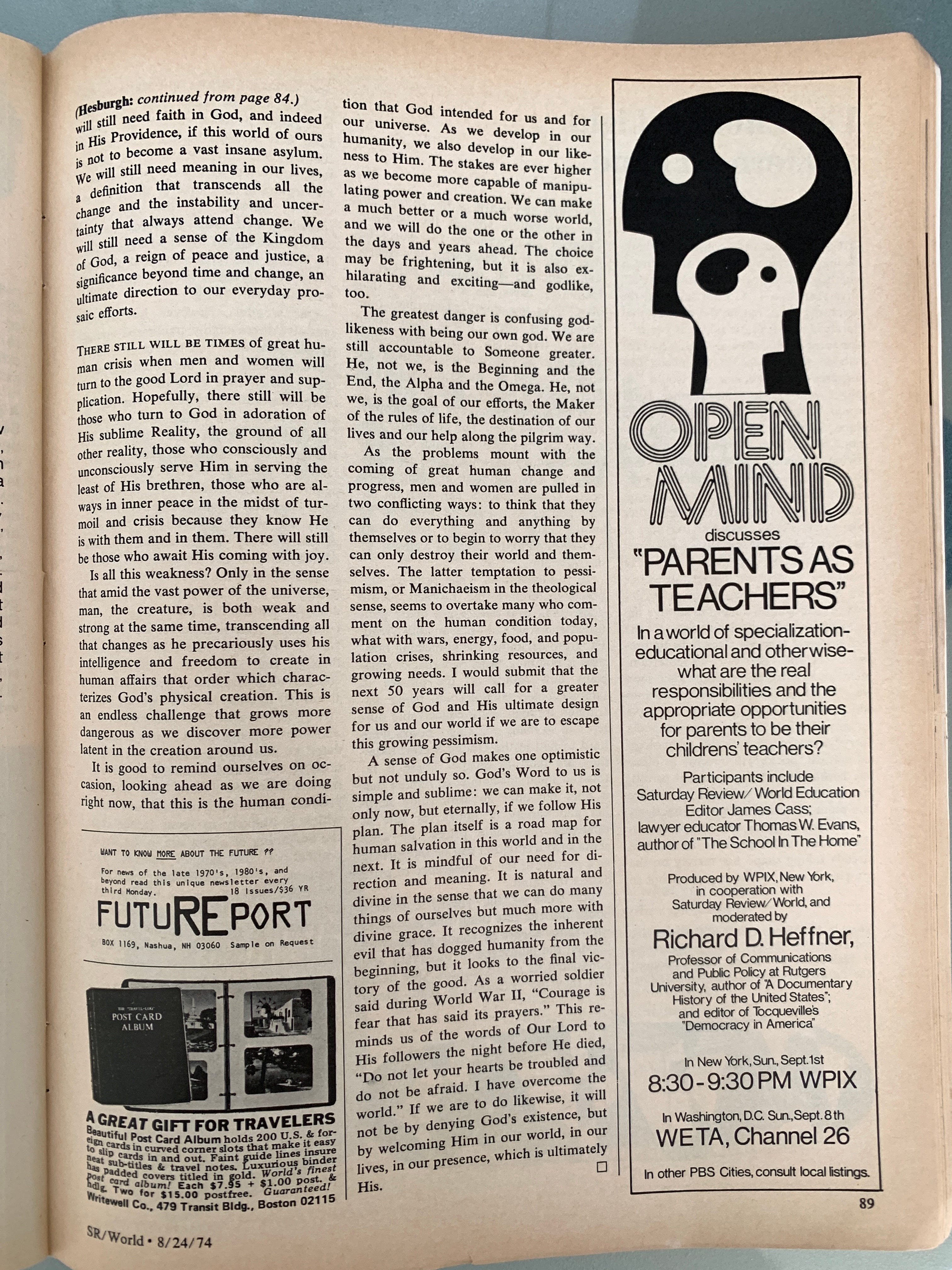Predictions of the Future from 1974
In 1974 a national magazine asked the “brightest minds” across a number of fields to predict the world of 2024
When I was eleven I remember stealing away with my dad’s magazine to see what the future would hold. It looked cool, and I kept the magazine with my stuff from that moment forward, keeping it for, pretty much, now. I figured most of you missed this, and it’s always interesting to see how smart people succeed and fail to predict things — so I bring you the Saturday Review World issue, August 24, 1974, pretty much in its entirety.*

Invitation to Domain Experts
If you’re a domain expert in one of the topics in this magazine, I invite you to critique the essay here — how it was correct or how it missed, and why — (and then if you’re willing, add your own forward prediction for 2074). Add a link to your essay in the comments (and mention the field) and I’ll insert them where they go in the scans.
*If something is missing, leave a note and I’ll scan and add it. I can also add the text-version of essays by request — although i must say the OCR efforts are riddled with odd mistakes.








Tomorrow: The View from Red Square by Andrei Sakharov






After the Deluge, the Covenant by McGeorge Bundy




A World Atlas for 2024






OUT OF THIS WORLD by Neal Armstrong








The Perils and Potentials of a Watery Planet by Jacques Cousteau




The Medical Prognosis: Favorable, Treatable, Curable by Dr. Michael DeBakey




Beyond the City Limits by Moshe Safdie




The 21st Century Woman — Free at Last? by Clare Boothe Luce








Education










Will There Still Be a God? by Rev. Theodore Hesburgh




The Literary Light as Eternal Flame by Norman Podhoretz






Recycling Social Man
The next fifty years must not be an extrapolation of today, but an original mode of life that seeks qualitative change rather than quantitative growth.
by René Dubos
I arrived in the United States as a 23-year-old immigrant in October 1924, half a century ago! I have moved a great deal since that time — from laboratory work in soil microbiology to interest in human settlements — all over the United States and to the most distant parts of the earth. Travel is now much faster than it was in 1924; yet paradoxically the adventurous young people of 2024 will find it more difficult than I did to change at will their nationality and occupation. Wars may become rare, but national suspicions will long persist. The world may be better organized, but this will mean more social regimentation and occupational standardization. On the whole, however, America will continue to be regarded as a land of Cockaigne, because our material abundance will still be beyond the reach of most other human beings. In many other parts of the world, soybean ersatz will be the nearest approach to gourmet dining, and a room of one’s own will be the height of selfish luxury.
We have reason to marvel at our technological achievements, but we must remember that they are only the current expressions of trends that were initiated more than a century ago; our own contribution has often been to push these achievements to the point of absurdity. Vigor and turbulence have been more characteristic of the past 50 years than originality of thought or understanding of real human needs. I am inclined to believe, however, that the next 50 years will witness a more humane and more original approach to life. An awareness is in the air that doing essentially more of what we have already done, only bigger and faster, is not for the sane and that we must find other ways to peace and happiness. The most significant contribution of the Seventies to the future may well be the rejection of the view that quantitative growth inevitably brings about a better life, and the beginning of a search for qualitative, rather than quantitative, changes. In this hope, I shall try to visualize 2024, not as an extrapolation of present trends, but as a picture of what human beings can achieve when they make up their minds to escape from social determinism.
THE 1933 CENTURY of Progress Exposition at Chicago was focused on the contributions of scientific technology to economic development. The social philosophy of its organizers was clearly stated as follows in the guidebook of the fair: “Science discovers, genius invents, industry applies, and man adapts himself to, or is molded by, new things. . . . Individuals, groups, entire races of men, fall into step with . . . science and industry.”
The extent to which this philosophy has influenced technological civilization is reflected in the many articles and books that were published during the Fifties and Sixties to forecast what the world would be like in the year 2000. Emphasis was then entirely on far-out technologies, with no mention of human needs. It was commonly assumed that there are no limits to the growth of science, that almost all scientific knowledge can be converted to practical ends, and that all technological developments eventually find a useful place in human life. From this it followed that we were about to enter a technological utopia. For several different reasons, however, the mood has now changed; pessimism prevails concerning the technological future.
Several theoretical physicists and biologists have recently gone so far as to affirm that there are limits to the growth of knowledge; in certain fields of science, according to them, we have almost reached the limits of comprehension of the human brain. It seems certain in any case that several of the most sophisticated technologies cannot go far beyond their present achievements, not because of deficiencies in know-how, but by reason of limitations inherent in natural laws. Here are a few examples:
With regard to health, an illustrious medical scientist has recently stated that the determinants of old age and of several degenerative diseases are woven into the genetic structure of the human species — in the very fabric of our bodies — and are therefore beyond our control.
With regard to communication, there is no point in increasing the speed of aircraft, because we can go almost anywhere we want in a few hours with existing equipment; and the speed of transmission of messages is already close to the ultimate speed, that of light. Explorations will soon slow down because every foot of the earth’s surface is now being photographed by orbiting satellites. Even the prospects for space travel are rather dreary. It takes only a few days to get to the moon, but it will inevitably take months to get to Venus, Mars, or Mercury, and years or decades to get to Jupiter and the outer planets.
For most people, of course, the limits to the expansion of scientific technology are to be found in the environmental dangers it creates. This concern reaches deeply into all classes, as illustrated by the results of a survey recently conducted among 3,000 Japanese scientists who were asked to state what they regarded as the most likely technological developments for the twenty-first century. In view of Japan’s phenomenal achievements in electronics, it could have been expected that this field would have headed the list, but, in fact, video telephones was at the bottom, whereas techniques for air-pollution control were at the top. Judging from the mood of the general public, as well as of the scientific community, it is unlikely that 2024 will be remarkable for any esoteric technologies. The emphasis will be, rather, on commonsense scientific policies designed to make the atmosphere and surface of the earth more as pleasant as they used to be.
One of the subtitles in the guidebook to the Chicago Exposition mentioned earlier was “Science finds, industry applies, man conforms.” The very etymology of the word conform implies that humankind would be molded by technological forces. It is precisely because many people no longer accept this fate that technological development will, from now on, have to take second place to environmental quality. The skeptics claim that environmental concern is just a fad and will vanish when the cost and inconveniences of effective controls become apparent. The new fact, however, is that the right to a good environment has come to be regarded as a natural right of man for which the community is responsible. A sign of this attitude was recently seen in Australia, where labor unions put a “green ban” on the construction of new energy plants until adequate anti-pollution measures had been taken, and then even refused to build a parking lot for the new Sydney Opera House because that would have meant cutting down three magnificent fig trees.
The formulation and implementation of sound environmental policies will, of course, be difficult. There will be popular resentment against control measures that appear unfair, elitist, or wasteful. But this will not make people forget that they are entitled to a good environment. There has never been a lasting retreat from the recognition of a natural right of man.
THE PRECEDING THOUGHTS might be interpreted as meaning that science has shot its bolt. What I believe instead is that science is in the process of reformulating its goals and will have come to grips with its social mission by 2024. Four centuries ago, Francis Bacon foresaw that knowledge could be used for trivial and destructive purposes, but this did not dismay him: “If the debasement of arts and sciences to purposes of wickedness, luxury, and the like be made a ground of objection, let no one be moved thereby. For the same may be said of all earthly goods.” Bacon reiterated over and over again that “knowledge is not to be sought either for pleasure of the mind, or for contention, or for superiority to others, or for profit, or fame, or power, or any of these inferior things; but for the benefit and use of life.” Like Bacon, most people still believe that science can greatly contribute to the enrichment of life.
For example, scientific criteria will increasingly be used in the definition of environmental quality; I shall mention one technical aspect of this problem that relates to economic policies. In the future, industrial and domestic effluents will be considered, not as wastes, but as resources; we shall develop new technologies to make use of them. In view of the expected worldwide shortage of many resources, recycling of wastes will become a socioeconomic necessity, and this will prove to be the most economical and effective method of pollution control.
Environmental quality, however, includes much more than chemical and physical cleanliness. Privacy, space, and quietness may not be essential for survival, but they are needs deeply rooted in human nature, and the demand for them increases with prosperity. Rural America came as close as any society has to providing these amenities when most people lived in freestanding, isolated houses. This kind of dwelling, however, is not likely to be common anywhere in the world of 2024.
The isolated freestanding house emerged at a time when there was much unoccupied, inexpensive land. Furthermore, the house was then essentially self-sufficient, with its own water supply from a well or a stream; its own fuel supply from the woodlot; much of its own food supply from the garden, domestic animals, and wildlife; and few problems from neighbors about waste disposal. In contrast, the freestanding house is now increasingly dependent on public services — for electricity, telephone, water, sewage systems, fuel for heating and transportation, and snow removal and road maintenance. Pleasant as it is, the way of life implied by the freestanding house now involves very high social costs, especially with regard to labor and energy. Both labor, energy, and open land will become increasingly scarce and expensive; the isolated freestanding house will become an economic burden too heavy for the average person, as well as becoming socially unacceptable. It is probable that social constraints will soon create a trend to some form of cluster settlements.
All over the world, in the poor as well as in the rich countries, planners and architects are studying how human settlements can be designed so as to provide both the technological advantages of cluster housing and the sense of space and privacy associated with the freestanding house. I am rather optimistic in this regard, and I doubt that 2024 will see anything as bad as the tenements of the mushrooming cities during the early phases of the Industrial Revolution.
THE UNITED NATIONS CONFERENCE on the Human Environment, held in Stockholm during June 1972, put special emphasis on pollution control and the management of natural resources — in other words, on the factors that play a role in the sustenance of our bodies and that make the environment enabling. These problems have been made universal by the general increase in mobility and by the standardization of technology. In this respect at least, the One World advocates have some chance of success. Standardization, however, will affect only limited aspects of life and the environment — for example, means of transportation, facilities for travelers, safety of air, water, and food, and other services common to large groups of people. The travelers of the twenty-first century will move through repetitive networks of airlines and throughways to reach a similar maze of lobbies, elevators, bedrooms, meeting rooms, snack bars, and restaurants. This will be boring but will help the traveler to orient himself in a new place and to function in it comfortably, thus sparing his time and energy for appreciating what is unique and interesting in the land of his destination.
While there is throughout the world a powerful trend toward uniformity with regard to those aspects of life that are common to all human beings, there is simultaneously an opposite trend toward regionalism. There will be many local worlds in the One World of 2024. One of the reasons for the survival of regionalism is that we demand more of the environment than providing health and economic security. The quality of our lives includes emotional and spiritual satisfactions that have their origin in our contacts with our physical and social surroundings. The very trend to uniformity and the sense of boredom it connotes tend to make us increasingly interested in the unique characteristics of the place where we live and in its traditional life styles. The cultivation of the sense of place will become increasingly important in the decades to come.
It seems incongruous to speak of spirit of place at a time when the mobility of people is so great and when surroundings change so fast that identification of a particular person with a particular place seems all but impossible. But there are still elements of stability in the technological world. Even in areas that have been plowed, bulldozed, built upon, there persist some stubborn peculiarities of the place that enable it to retain its identity — some local characteristics of the air and of the light, despite the smog; a relationship between soil, rock, water, and slopes despite manipulation by real-estate developers; the rhythm of the seasons despite the promiscuous use of air conditioning; an awareness of the past despite the disappearance of landmarks and monuments. The persistence of topographical, climatic, and historical evidences of uniqueness affects the attitudes of people toward life and helps them in maintaining traditions that, though they may be subconscious, are reflected in social behavior and even in mannerisms of speech.
The trend to regionalism is worldwide. Each nation and ethnic group uses the United Nations as a platform to publicize its identity. Folklore, historical societies, and local museums are in fashion; they are witness to the fact that regional loyalty is more natural to humankind, biologically and socially, than rootless drifting. Although there have been vast movements of population in the past, the migrants eventually settled down to become the local peasantry and aristocracy. Mass movements still occur now, but they do not last long. Even in the United States, mobility eventually evolves into a regionalist culture. Poets write about the open road, but few people elect hobo life. Even so-called mobile homes generally stay put.
The unanswered question is, Who settles where? Most people, of course, are compelled to stay where they are by the accidents of life, or to go to a particular place simply because economic opportunities are available. But, increasingly, environmental tastes play a role in the selection of a place for work or for retir ment. Some people prefer a relaxing sub-tropical atmosphere; others, a rugged, stimulating scenery and climate. Some like pastoral scenes; others, a desert or wooded wilderness. Some want the peace of a sleepy village or small town; others, the diversity and excitement of a cosmopolitan metropolis. More importantly, perhaps, many people are eager to find a place that suits them as a stage for action; they are not so much place-seekers as place-makers. Throughout history, place-makers have shaped the distinctive characteristics of landscapes and cityscapes, regardless of natural forces and economic considerations, Land use in France differs from what it is in England, not because of differences in natural history, but because place-makers have imposed on each country a distinctive pattern of man-nature relationships. Similarly, the cityscapes and landscapes of Sweden differ from those of other Scandinavian countries as a consequence of human interventions into nature.
Regionalism in the United States has the special interest that its historical determinants are of recent origin. In any given area the percentage of natives among the residents is likely to be small, but dedication to the spirit of place is commonly the highest among the new- comers. The people most eager to save the Vermont or the Oregon countryside are those who have recently moved into it from other states where the countryside has been spoiled. Choice, rather than birth, determines residence. On the whole, mobile people settle in a particular place for aesthetic, rather than economic reasons. The Vermont farmer who left New Hampshire, the other day, to settle in New Hampshire, moved in the same way as people moved to the Arctic territories, the Yukon, and Alaska to find themselves. And the same can be said for an Oregon versus Washington, Arizona versus Southern California, and even for cozy Connecticut versus New York, the Empire State.
Regionalism used to be the expression of natural forces and historical accidents. But greater geographic and economic mobility has increased the latitude in the selection of a place. It is probable that the greater possibilities for economic choice of residence will encourage more thoughtful efforts to cultivate the spirit of place and make it come alive in human activities.
EVERY PART OF THE WORLD has some kind of plan for its long-range future. Most prosperous, highly industrialized countries are concerned with environmental quality and question the advisability of further industrialization. In contrast, all poor countries aim at rapid development by the most sophisticated technologies, even at the expense of environmental quality and of their traditions.
The Mandate from Heaven that justified the absolute rule of the ancient Chinese emperors has been reincarnated in Mao Tse-tung’s wisdom and will survive in a technocratic form after China has been industrialized. In the communes of present-day rural China or of Shanghai, the nuclear family is as strong and important as it was in imperial China, even though the social contexts in which it operates are now completely different from those of the past. Social changes can hardly be successful unless they achieve a large measure of conformity between the new and the old — in other words, unless the spirit of place survives.
I SHALL USE the current increase in the cost of energy to illustrate how the adaptive responses to a single change differ from one social and technological situation to another.
First, I must point out that modern agriculture requires enormous amounts of energy — for the construction and operation of tractors, trucks, and other equipment; for the production of fertilizers and pesticides; for drainage, irrigation, and so forth. The modern farmer spends more “industrial calories” than he recovers from the land in the form of food calories. Because modern agriculture can thus be regarded as a technique for the conversion of fossil fuels into foods (and also into textiles), it is inevitable that the cost of agricultural products will go up everywhere with the cost of fuels, but the social effects will be qualitatively different depending upon the levels of industrialization.
In the poor countries, which are not yet industrialized, agricultural yields are commonly rather small, but they are obtained by traditional practices which require little energy except that provided by human and animal muscles. In theory, the agriculture of poor countries could be vastly improved by the use of seeds potentially capable of producing enormous yields — the so-called Green Revolution. In practice, however, the “miracle” seeds are effective only where farmers can afford extensive use of fertilizers, pesticides, and irrigation. The higher costs of energy therefore link the success of the Green Revolution to the economics of these practices. Because massive use of fertilizers, pesticides, and irrigation cannot possibly take place without huge technological resources, food shortages are likely to occur in the overpopulated parts of the world, which have put their hopes in the Green Revolution. On the other hand, there are reasons to hope that poor countries might increase their food production by improving their traditional agricultural practices. From all accounts, this is what has happened in China during the past two decades. Farming as now practiced in the Chinese commune is scientifically less innovative than farming based on the use of miracle seeds, but it is more likely to serve as a basis for an orderly social evolution.
Higher energy costs may also force a rethinking of modern agriculture in the industrialized countries. In this case, however, the solution is likely to be found, not in an improvement of traditional practices, but instead in a further industrialization of agricultural techniques. Control of light, temperature, humidity, and carbon-dioxide tension of the air would permit a much more effective utilization of solar energy by a great variety of crops. A truly scientific industrialized agriculture would probably result in more efficient use of land, fertilizers, pesticides, water, and also energy. Large-scale production of some crops in greenhouses has already become common practice in overcrowded countries, such as Holland, Belgium, England, and Japan. By 2024 the industrialization of agriculture may have gone so far that it will have released marginal farmland and allowed it to return to a state of wilderness, even if the world population continues to increase.
HIGHER COSTS of energy will serve as a catalyst for the restructuring of human settlements and of life-styles. In rural areas and small towns, the clustering of residences will make for economies in fuel consumption, in access to utility lines, in the maintenance of roads; it will shorten distances to shops and schools; it will facilitate group activities and thereby foster community life. The local density of population will thus increase over what now prevails in American communities. This will not pose difficult problems of adaptation, because contrary to what is commonly believed, practically all of human life everywhere on earth has been spent, until our times, in compact villages or other dense settlements. The present forms of urban crowding are unquestionably stressful, but this does not mean that people want solitude. In the country, as in the city, they like to be together, provided that they can live and act under pleasant conditions. The objections to crowding are directed much less to the human beings themselves than to the mechanical contrivances and bedlam that spoil the quality of the human encounter.
Clustering will provide better opportunities for the organization of special sites devoted to communal life. Where space is at a premium, clustering will allow for more open areas to be used as playgrounds and for more wooded areas that, in addition to their picturesque value, will shelter against noise and reduce the need for air conditioning. The village green and the public square are not likely to survive in their traditional forms, but with the new formula of land use and architectural design they will evolve into new kinds of public spaces suited to the activities of modern life and to the revival of community spirit. As mentioned earlier, the human structure of the place will not be determined, as in the past, by the accidents of life, whether place of birth or economic necessity, but by the selection of physical and human surroundings suited to one’s temperament.
Repeatedly throughout this essay I have stated that future trends will re-emphasize the locality — the spirit of place. One of the reasons is that human beings are at heart sedentary. They experience wanderlust only on rare occasions; moreover, they are learning that the open road commonly leads to the parking lot or even to the garbage dump. Another reason is that man is biologically a social animal; he cannot function well and fully unless he is part of a well-defined social structure. One of the great potential advantages of modern mobility is that it gives much more freedom in the selection of such a structure. The energy crisis points to the possibility of reconciling the inescapable necessity for a larger social order leading ultimately to a world order, with the longing for the life of the region or even of the neighborhood.
By 2024 the reserves of fossil fuel will be nearly exhausted, but new techniques for the production of man-made sources of energy will have been developed. Some of these sources will be in the form of huge power plants suited to the high-energy kinds of technology and to projects of national and interntional magnitude; they will favor the trend to internationalism and uniformity. Others will be in the form of much smaller plants — probably of an entirely different nature and suited to local uses and to soft technologies. The ideal of village life, which has persisted since neolithic times, will be incorporated in, but not absorbed by, the anonymous life of the world community. Communes for ordinary citizens — even for commuters — might help people in 2024 to recapture a sense of self-sufficiency, community life, and contact with nature.
CHANGE THERE MUST BE, because it is an essential condition of life. But change can be successful only if it occurs within the constraints imposed by the ecological characteristics of each locality and by the unchangeable demands of human nature. The human species acquired its genetic constitution some 100,000 years ago, and there is no chance that it can be significantly and safely altered. However, granted the biological and psychological stability of our species, the immense diversity of its attributes enables human beings to express many trends in their individual lives and in their societies. Human beings can be selfish or altruistic, careless or fastidious, home-loving or eager to take to the open road. As already mentioned, their civilizations move simultaneously toward international uniformity and toward regional differences. This fundamental diversity makes human behavior pleasantly unpredictable and accounts for the fact that the future is hardly ever an extrapolation of the past or present.
Our very notion of progress also reflects conflicting tendencies. The ancient myth of eternal return is counterbalanced by the belief that everything is forever changing toward some omega point. The Bible teaches that there is nothing new under the sun but also that we must build the New Jerusalem.
Experience shows that human affairs exhibit recurring cycles, just as do the seasons, the movements of the celestial bodies, and all other natural phenomena. In this light, the human condition at any given time is but one stage in the endless ebb and flow of events. The myth of eternal return has great appeal, because it provides the satisfaction of experiencing diversity while being part of eternity. On the other hand, Western civilization is committed to a dynamic view of life that implies continuous change — a belief in the possibility of progress, which is as ancient as the Greek myth of Prometheus. Most people now take it for granted that modern civilization is engaged in a continuous process of change to a new state that will certainly be different from anything in the past, even though it may not be better.
During the past two decades, our attitude concerning progress has itself begun to change. We realize that the new is not necessarily preferable to the old and, especially, that our own type of civilization is not superior to others — even those we consider primitive — when the quality of life is used as the criterion of comparison, instead of technological power. We also feel that a tangible link to the past is an essential component of happiness; one of our painful experiences is finding that to go home is bearable only for a short visit, because so little is left to which we can relate. We long for a kind of social order that will give us, as did the myth of the eternal return, not only the excitement of change but also the security of returning to a state and place in which we feel at home.
Whether we look forward to material progress or long for the good old days, there is no doubt, in any case, that the world has changed greatly since the beginning of the Industrial Revolution and that it will continue to change. I rejoice in most of the changes because I believe that we cannot be fully human without seeking new experiences — the adventures of the spirit as well as of the flesh. But I also believe that the transformations of the physical world have been, and will be, less significant than commonly assumed — the reason being that the most important manifestations of human life have characteristics that are unchangeable and universal. Homer, Shakespeare, Racine, will remain meaningful to us simply because the passions they portray will remain the passions that move the world.
The permanent aspects of our constitution are thus at least as relevant to the future as are diversity and change. The world of 2024 will be interesting and creative to the extent that it will provide opportunities for the expression of the opposite, complementary urges embodied in the biological and psychological nature of the human species. Bob Dylan states an eternal truth when he sings, “The times they are a-changin’.” But he should add to his message that it is the same human nature and the same physical nature that are being eternally recycled during the change.
